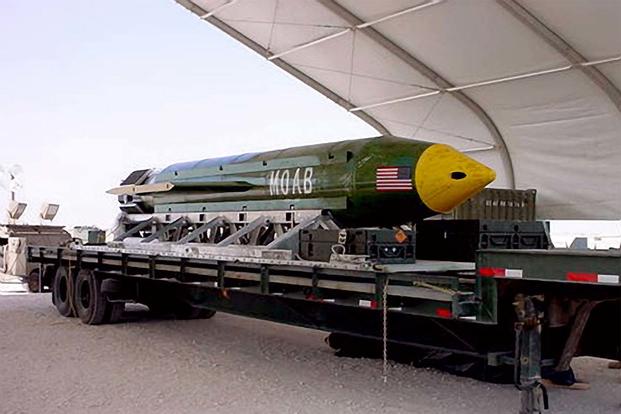The U.S. military on Thursday dropped the most powerful non-nuclear bomb in its arsenal against the Islamic State in Afghanistan, marking the first ever combat use of the massive ordnance.
An Air Force MC-130 special operations aircraft dropped the 21-000-pound GBU-43 Massive Ordnance Air Blast, or MOAB, bomb against militants affiliated with the Islamic State of Iraq and Syria's branch called Khorasan, or ISIS-K, which operates in Afghanistan and Pakistan, according to U.S. Central Command.
"As ISIS-K's losses have mounted, they are using IEDs, bunkers and tunnels to thicken their defense," Gen. John W. Nicholson, commander of U.S. Forces-Afghanistan, said in a statement, referring to improvised explosive devices. "This is the right munition to reduce these obstacles and maintain the momentum of our offensive against ISIS-K."
The strike took place at 7:32 p.m. local time and targeted a tunnel complex in the Achin district in Nangarhar province, according to the statement.
RELATED: Watch the Air Force Test the 'Mother of All Bombs'
The mission comes less than a week after a U.S. Green Beret was killed in action Saturday in the same province. Staff Sgt. Mark R. De Alencar, 37, of Edgewood, Maryland, died of injuries sustained when his unit came in contact with enemy forces using small arms fire. He was assigned to 1st Battalion, 7th Special Forces Group (Airborne), Eglin Air Force Base, Florida.
During a brief press conference, President Donald Trump was asked whether he authorized the mission.
"Everybody knows exactly what happened," he said. "We have given them total authorization and that's what they're doing," he added, referring to military leaders. "Frankly, that's why they've been so successfully lately ... we have incredible leaders in the military and ... we are very proud of them. This was another very, very successful mission."
When asked whether use of the bomb -- known as the "mother of all bombs" -- sends a message to North Korea, which has threatened to test more missiles and nuclear weapons, the president said, "I don't know … It doesn't make any difference if it does or doesn't. North Korea is a problem, the problem will be taken care of."
At a White House briefing earlier in the day, spokesman Sean Spicer confirmed the GBU-43 was dropped on a cave and tunnel complex used by the ISIS offshoot.
"We must deny them operational space, which we did," he said.
To illustrate how big the GBU-43 conventional ordnance is, a Tomahawk cruise missile -- the type of munition recently launched from U.S. warships into Syria in response to a chemical attack -- weigh about 1,000 pounds.
The bomb, which is made by Dynetics Inc., releases from a weapon cradle in the MC-130 within seconds and relies on Global Positioning Satellites, or GPS, for guidance, according to an Air Force official who spoke to Military.com on background. It features controllable fins to accurately maneuver to within less than eight meters of the intended target, the official said.
Based in part on technology from Soviet-era intercontinental ballistic missiles, as previously reported by DefenseOne, the MOAB was tested at Eglin in 2003 but until Thursday has never been used in combat.
The bomb has the highest yield of any conventional ordnance in the U.S. stockpile. (The biggest, however, is the GBU-57 Massive Ordnance Penetrator.) Yet while the GBU-43 isn't a penetrating bomb, the force of the blast would likely kill militants in tunnels and potentially anyone in the vicinity.
"U.S. forces took every precaution to avoid civilian casualties with this strike," according to the statement, and "will continue offensive operations until ISIS-K is destroyed in Afghanistan."
Thomas Donnelly, a resident fellow at the American Enterprise Institute, said it was "about time" the munition was employed.
"The narrow valleys of eastern Afghanistan have been redoubts of insurgents for centuries," he said. "The MOAB was made for operations like this, and perhaps the terrain even enhanced its effects."
Donnelly added, "While, as in Syria, one mission does not a doctrine make, this is a small but encouraging sign that the Trump team is getting serious about the wars it inherited; they might simply have thrown up their hands, blamed their predecessors for the sorry state of affairs and walked away."
Jason Dempsey, a senior fellow at the Center for a New American Security and former Army infantry officer who deployed twice to Afghanistan and has written extensively about the country, said it's unlikely the strike caused many civilian casualties because Nangarhar is very remote and mountainous.
"I'm sure this is ISIS making a pretty big mistake of setting up something remotely and massing," he said in a telephone interview with Military.com.
Dempsey also downplayed the symbolism of the military's decision to use this particular munition.
"It's a bomb, it's the same as dropping 20 smaller bombs," he said. "And it's going for very distinct effect. It's a cave complex, and to destroy a cave complex you need a giant bomb. So for one, I'm not too wrapped up on the uniqueness of the bomb."
Dempsey added, "This is a reflection of our future in Afghanistan, and it's the best tool we have with the reduced footprint. As Afghanistan transitions to what will be almost solely a counterterrorism mission, we've got a group of folks there monitoring transnational terrorist threats, and when they pop up, we're going to bomb them. We certainly can't send the Afghans into a complex like this. This is the new normal for Afghanistan."
-- Hope Hodge Seck, Richard Sisk and Brendan McGarry contributed to this report.
-- Oriana Pawlyk can be reached at oriana.pawlyk@military.com. Follow her on Twitter at @Oriana0214.
Related Video:
The U.S. military dropped the MOAB bomb April 13, 2017, against Islamic State militants in the first ever combat use of the munition. (Defense Department video)



























